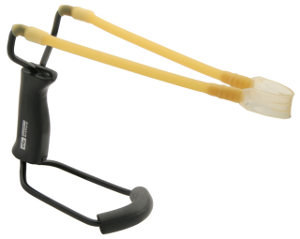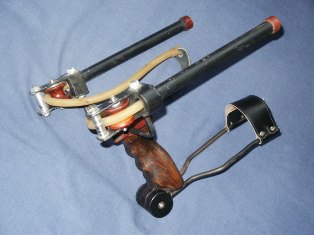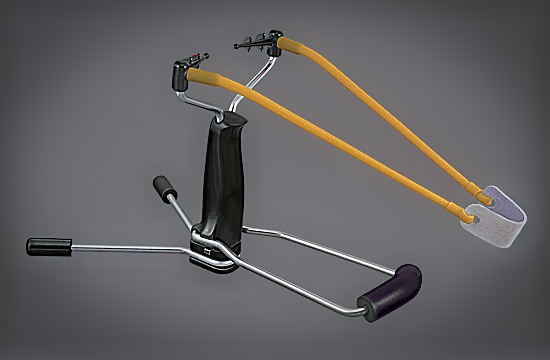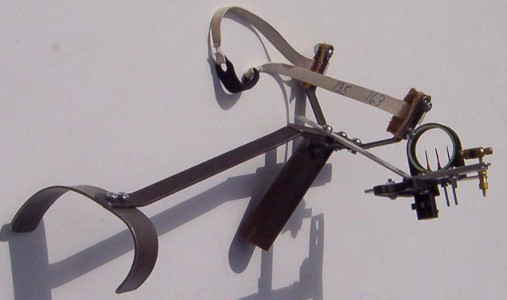













Basically, a slingshot frame is nothing more than a grip with two prongs hang the rubber bands on. Most shooting characteristics - such as draw weight, velocity, band life - are mainly defined by the choice of ammunition and the type of bands you use.

A wristbrace wrapes around the forearm. Hand, slingshot and arm form a rigid shooting platform. This has several effects. First, stress is taken away from the wrist, which is helpful when strong bands are used. Second, the brace directs the hand in the same position every time. Beginners typically profit a lot from wristbraces, while experienced shooters often switch back to classic designs. Third, wristbraces that extend from the slingshot's bottom are effective safety devices, as they "lock" the slingshot firmly into the hand, even when the shooter loses grip on the handle. The latter two features make wristbraced slingshots very attractive for introducing beginners to slingshooting.
A drawback is that wristbraces must be individually fitted to the shooter - else, they sometimes do more bad than good, as they force you to hold the slingshot at an awkward angle. Don't hesitate to bend them to suit your needs. Some countries - such as Germany, Australia, New York state - outlaw wristbraced slingshots. Why somebody wants to outlaw a device that is essentially a comfort /safety feature and does in no way increase the power of a slingshot is beyond my understanding.

A fork extension moves the attachment points of a slingshot forward. The increased draw results in a much higher performance - that is, you can achieve a higher velocity with the same draw weight. This is appreciated by hunters and long-range target shooters.
Constructing a slingshot with fork extension is not as easy as it seems. You need a long wristbrace, else the slingshot will try to turn around in your hand. The angle of handle, fork and wristbrace must fit each other - else, the extended fork will sit too high and give you a huge leverage, or sit too low to use the slingshot at all. A fork extension also inceases the slingshot's size considerably, unless a folding mechanism is incorporated.

If you put a pulley on each side of the fork, you can increase your draw length without adding a huge fork. However, the pulleys usually limit the types of bands you can use. You may also experience accuracy issues due to uneven pulley movement and still have a bulky slingshot -the bands must go somewhere. Friction also takes away some of the power. Only few slingshooters use pulleys.

A stabilizer helps you to reduce the movement during the shot. This can be an advantage or not - depending if you "flip" the slingshot or prefer to keep it still during the shot. Stabilizers are often seen on tournament slingshots, but are a rare sight in pocket or hunting slingshots. If you decide to use a stabilizer, take a long and heavy one. Tiny

Every slingshooter who gets disappointed with his shooting results starts to think of a sight sooner or later. Problem is, a sight does not magically leat your ammo into the bullseye. A firearm has a long barrel that can be equipped with front and rear sight, but a slingshot can only accept a front sight that does not much more than the fork tips already do - give you reference points which help you to train your slingshot on the target. That being said, it is worth to be noted that some shooters feel they profit a lot from sights that can be adjusted to point directly at the target at a given distance, while other shooters think such sights only distract from a view on the "big picture" that includes target, bands and fork ends.
Sights come in varying shape and size. Everything from a notch on the fork end to fully adjsutable fibre-optic devices are being used. Many sights have a vertical line of reference points for different target distances.
Many beginners fall for the looks of add-ons, and believe that a buffed up slingshot with all whistles and bells is inherently better than a simple y-framed model. Some purists are the opposite, and think that only a tree fork is a true slingshot. I hope you have a rational approach towards the options in slingshot design. Use the type of slingshot that works for you, matches your shooting style and is compact enough to be carried to the places where you like to shoot.